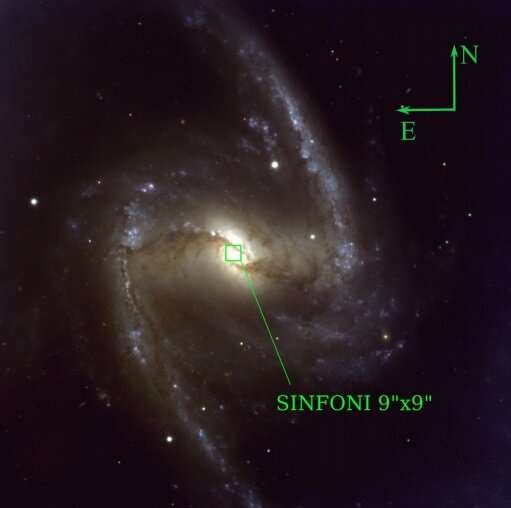February 4, 2019 report
Astronomers study star formation and gas flows in the galaxy NGC 1365

Using European Southern Observatory's Very Large Telescope (VLT), astronomers have investigated the galaxy NGC 1365. The study, presented in a paper published January 18 on the arXiv.org pre-print server, reveals essential insights about star formation processes and gas flows in this galaxy.
Located some 56 million light years away in the Fornax cluster, NGC 1365, dubbed the Great Barred Spiral Galaxy, is a barred spiral and ringed galaxy of Seyfert type. Although many observations of NGC 1365 have been conducted to date, it has not been yet thoroughly studied at mid-infrared wavelengths.
In general, mid-infrared observations have the potential to uncover crucial details about molecular gas clouds and ionized gas, which is key to study the distribution and kinematics of the mass-dominating old stellar population in galaxies. Such observations could also provide important information on star formation history and properties of central engines of galaxies.
A team of European astronomers led by Nastaran Fazeli of University of Cologne in Germany performed near-infrared observations of NGC 1365 hoping to learn more insights into gas and stellar kinematics in this galaxy. In their observational campaign, the researchers concentrated on the approximately 2,600-light-year-wide circumnuclear region of NGC 1365, studying it using the Spectrograph for INtegral Field Observations in the Near Infrared (SINFONI) instrument on VLT in Chile.
"In the framework of understanding the gas and stellar kinematics and their relations to AGNs [active galactic nuclei] and galaxy evolution scenarios, we present spatially resolved distributions and kinematics of the stars and gas in the central ~800-pc radius of the nearby Seyfert galaxy NGC 1365," the astronomers wrote in the paper.
SINFONI observations resulted in detecting parts of the starburst circumnuclear ring (with a radius of about 3,260 light years) and resolving some weaker starburst regions within the inner ring and the nucleus (radius of approximately 1,000 light years). The researchers found that the circumnuclear ring has strong emitting "hot spots" in optical wavelengths, which have starburst ages below 10 million years with an age gradient on the west side of the ring.
The study also revealed strong broad and narrow emission-line components of ionized gas in the nuclear region, as well as hot dust with a temperature of approximately 1,300 K. The researchers noted that these properties are typical for type 1 AGN.
Observations indicate that the stellar velocity field of NGC 1365 shows an overall rotation. Moreover, ionized and molecular gas show an overall rotation in the general orientation with the stellar velocity.
The astronomers calculated that the galaxy's black hole mass is from five to 10 million times greater than the mass of our sun. They found that the hot molecular gas is around 615 solar masses, what corresponds to a cold molecular gas mass at a level between 200 and 800 million solar masses. Additionally, the ionized gas mass was estimated to be about 5.3 million solar masses.
More information: Nastaran Fazeli et al. Near-infrared observations of star formation and gas flows in the NUGA galaxy NGC 1365. arXiv:1901.06241 [astro-ph.GA]. arxiv.org/abs/1901.06241
© 2019 Science X Network





















